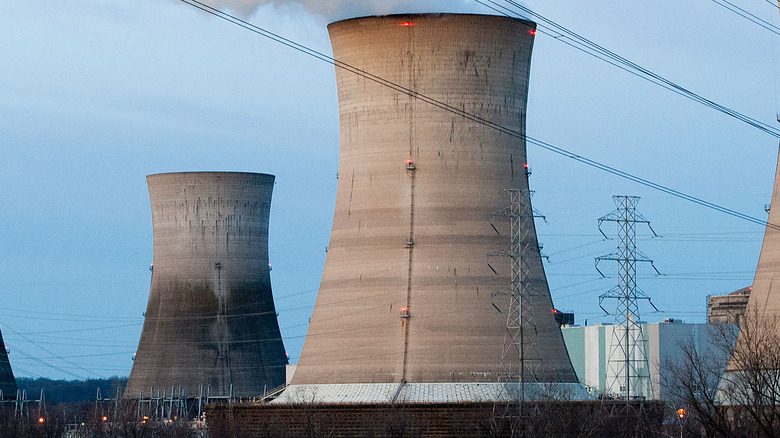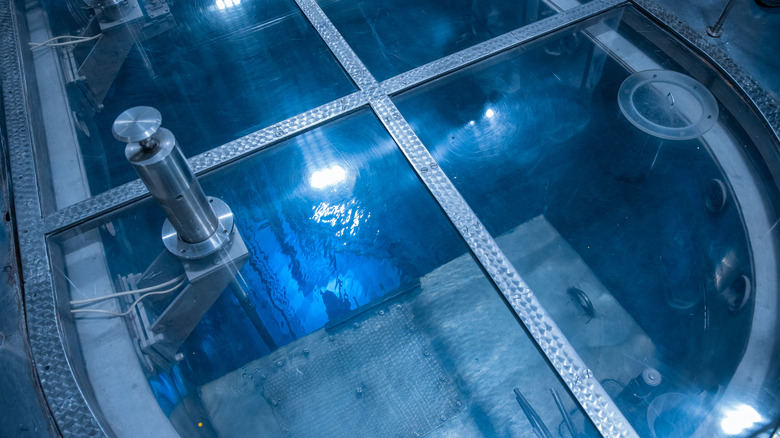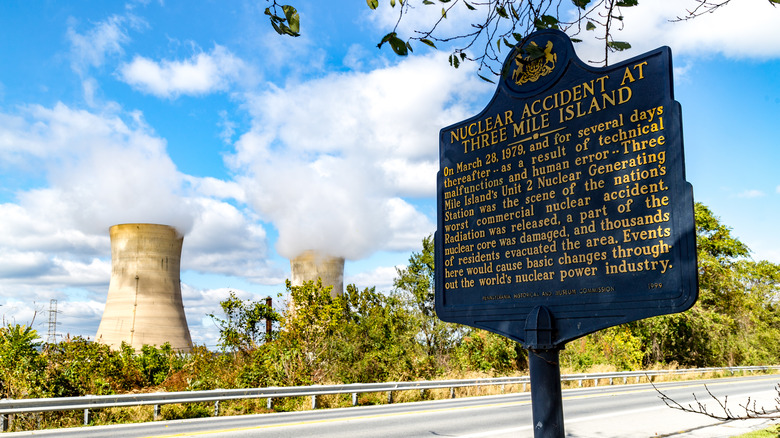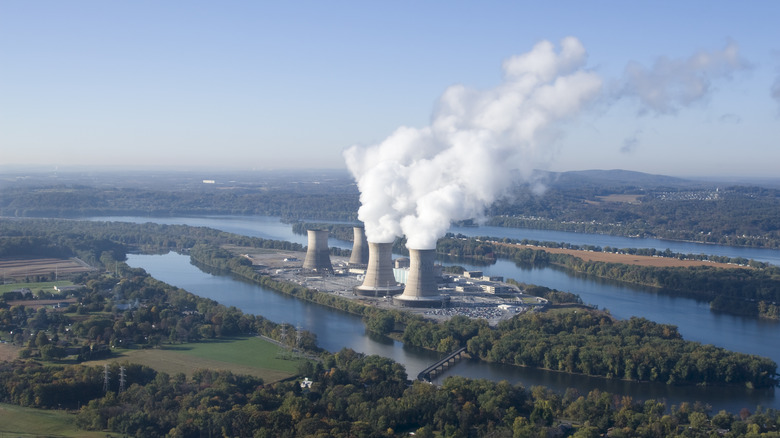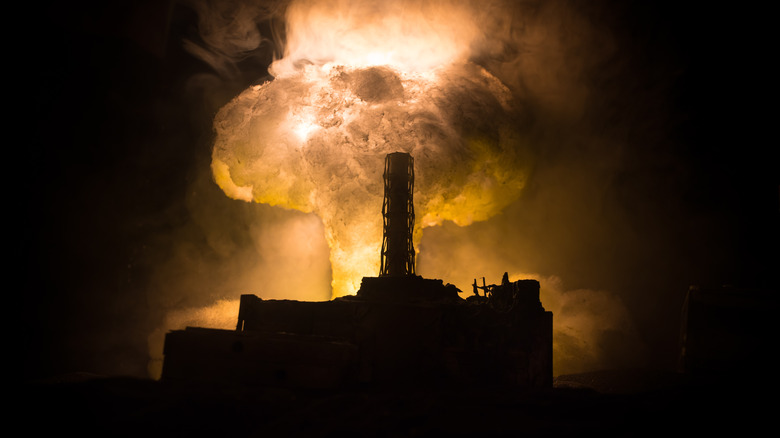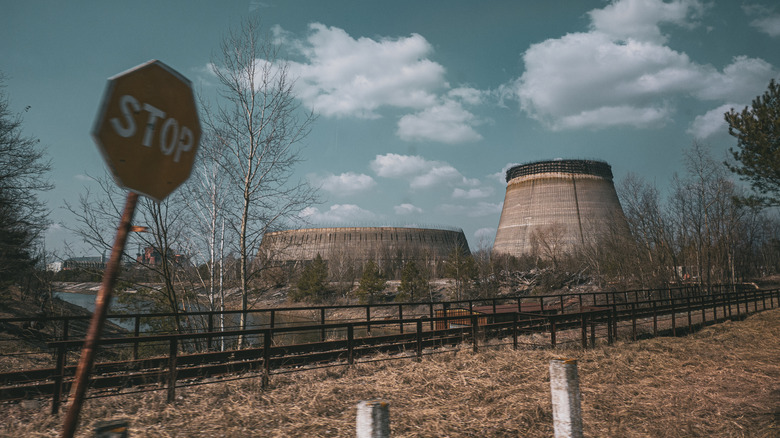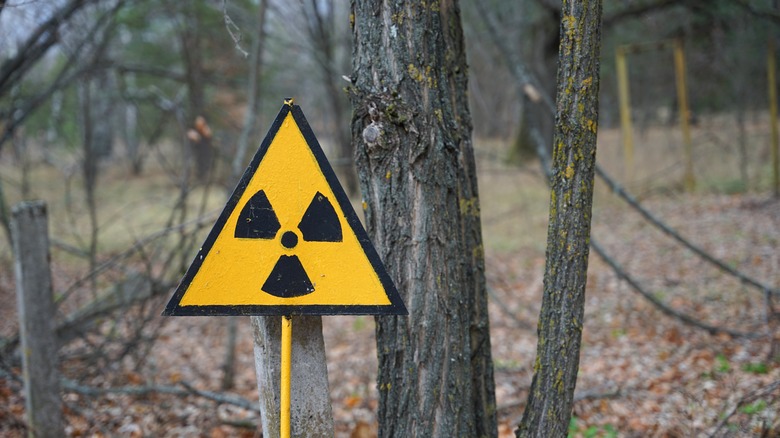Comparing The Three Mile Island Meltdown To The Chernobyl Disaster
Given that they occurred within 10 years of each other and in the midst of the Cold War, when nuclear tensions were at their highest, Three Mile Island and Chernobyl are names that jump to mind when discussing nuclear incidents. Both of these plants were situated within the borders of the two main Cold War belligerents and provided a first-hand look at the potential dangers that come with nuclear power.
However, the two incidents were very different, both in how they occurred and the scale of the damage caused. The area surrounding Chernobyl is still highly radioactive and a still largely uninhabited exclusion zone was put in place, per the World Nuclear Association. Meanwhile, Three Mile Island didn't appear to cause the amount of damage as that of its Soviet counterpart. Studies have indicated that there were no casualties and that no one in the vicinity suffered adverse effects from any radiation. However, residents in the area have provided their own anecdotal evidence to the contrary (via Penn Live).
A crash course in nuclear power
Before getting into what happened at both Three Mile Island and Chernobyl, it's probably not a bad idea to go through a quick refresher on the nuclear energy process. Nuclear energy is the energy found within the nucleus at the center of an atom. A nucleus is dense but full of energy. The question is, how to get to it? Fortunately, some very smart people figured out the process of nuclear fission. According to National Geographic, nuclear fission is the name for the process used to crack atoms open and release the enormous stockpile of energy inside their nuclei. A nuclear reactor is a series of machines that can safely — ideally — conduct this process and which involves a series of uranium atoms splitting and releasing energy.
The energy inside each nucleus is released in the form of heat. The water surrounding the reactor is intended to act as a cooling agent. The heat energy turns the water into steam, which then turns turbines that generate electrical energy. In short, think of how windmills work: Wind turns the turbine which generates electricity. Now, simply replace wind with steam that has been superheated by nuclear energy.
The Three Mile Island meltdown
Three Mile Island is a nuclear energy plant that sits on an island in the middle of the Susquehanna River, about 10 miles south of Pennsylvania's state capital, Harrisburg. The plant opened in 1974, according to History, but just five years later the nuclear power plant providing electricity to homes in south-central Pennsylvania grabbed international headlines for all the wrong reasons.
On March 28, 1979, some of the cooling water started leaking out of the plant's Unit-2 generator. This would've been a problem and led to the reactor overheating, but fortunately, the reactor was equipped with safety features to automatically remedy this kind of situation. However, according to History, the emergency cooling system presented the operators sitting in the control room with some unusual readings. They deactivated it and shut down the reactor. So much heat is generated via nuclear fission that even with the reactor turned off the heat left over heated the core to within 1,000 degrees of a meltdown.
Within 24 hours it appeared the crisis had ended, though radioactive gas had leaked into the facility and even drifted outside. But two days later a hydrogen bubble was discovered in the reactor, which prompted fears of an explosion (via Britannica). Pennsylvania Governor Dick Thornburgh advised pregnant women and young children to evacuate the area. This suggestion stirred up panic in the surrounding area, and it's estimated that 100,000 people evacuated.
The Three Mile Island aftermath
Fortunately, the explosion never came to be, and President Jimmy Carter — who had been a nuclear technician in the United States Navy, per PBS — toured the facility just a few days later on April 1, 1979. Still, the major concern was that the plant had released radiation that would lead to health issues for those in the surrounding area.
According to a report from the World Nuclear Association, the Pennsylvania Department of Health kept tabs on around 30,000 residents for 18 years after the accidents, but stopped in the mid-1990s when there weren't any notable adverse findings. It did note that some of the residents had suffered from psychological stress. However, some residents have claimed that there has been an increase in cancer diagnoses in the years since, despite the official indication that the amount of radiation released into the atmosphere from the incident was less than that from a typical x-ray machine (via PennLive). There have also been reports of locals experiencing nausea, hair loss, and skin irritation as well as reported issues in local plant and animal life.
There is still debate over the long-term effects of the Three Mile Island incident. According to NPR, the plant itself was shut down in 2019, but the decommissioning process could take decades to make sure that nuclear waste is disposed of properly.
The Chernobyl disaster
Just seven years after the incident at Three Mile Island, the Soviet Union experienced its own nuclear incident, but this time there was no debate over its severity. The Chernobyl power plant is actually located about 10 miles away from Chernobyl itself, closer to the city of Pripyat. The plant is currently located in Ukraine, but in the 1980s — like much of Eastern Europe — it was part of the Soviet Union.
In April 1986, one of the plant's four reactors exploded. The explosion was the result of a buildup of steam which occurred, due to what was later determined to be a faulty reactor design, per the World Nuclear Association. This explosion destroyed the entire reactor and released an estimated 5% of the core's radioactive material straight up into the atmosphere, which then rained back down to Earth as what is called fallout, according to National Geographic. Unlike at Three Mile Island, there were immediate fatalities — two of the plant's workers were killed by the explosion.
Around 100,000 people in the surrounding area were quickly evacuated in the immediate aftermath of the explosion. Most of the effects became clear in the months and years that followed, but other signs of the incident's impact were immediate, with pine trees near the plant drying up and dying soon after the blast.
The aftermath of Chernobyl
In addition to the two plant employees killed in the initial explosion, another 28 people — a combination of workers and firefighters — died in the weeks that followed, most of them falling victim to acute radiation poisoning, according to the World Nuclear Association.
The radiation cloud didn't hover above the power plant. Winds moved radioactive particles all across Europe, with some detected as north as Scandinavia. The widespread radiation cloud is one of the reasons why it's hard to give an exact answer as to how many people were affected and how severely. According to National Geographic, sometimes the effects of radiation poisoning don't appear until years later. Meanwhile, cancer cases in the area would lead one to suspect that the Chernobyl disaster was a factor, if not the cause, of a person's diagnosis, but this can be hard to prove. Meanwhile, both cattle and horses were killed by radiation, and such high levels have been found in fish from nearby rivers that they are no longer edible.
In the years that followed, thousands worked to clean up the plant and get the remaining reactors operational, receiving doses of radiation for their troubles. A giant sarcophagus was built over the site of the destroyed reactor, meant to trap the remaining radioactive material. Parts of the plant went back online in 2004, but it wasn't out of the news, as in 2022, Russian forces invading Ukraine seized the plant. It was reported that in the process of their takeover, radiation levels have since increased (via CNN).
How do Three Mile Island and Chernobyl compare?
While Chernobyl appears to have caused the most devastation among the two accidents by a considerable margin, both were highly influential in shaping nuclear energy-related policy. It was eventually determined that human error was a factor in both of the incidents (via Britannica). Three Mile Island was the first to reveal that leaving a human element in the highly complicated nuclear energy process was actually risky, despite the initial belief that humans served as a fail-safe in the process. New training programs and equipment were introduced which did increase safety and reliability, although they made the operating costs of nuclear facilities much higher.
Although neither Chernobyl nor Three Mile Island currently produce power, they do still need to be managed and maintained, per BBC. However, unlike Chernobyl, there is no exclusion zone around Three Mile Island, given the lower levels of radiation thought to have been released in 1976. Chernobyl's exclusion zone, which was once home to over 100,000, is only thought to have around 500 to 1,000 residents who moved back to the area despite the warnings and dangers (via Radioactivity E.U.).
